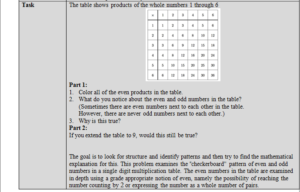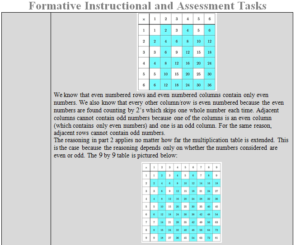Identify arithmetic patterns (including patterns in the addition table or multiplication table), and explain them using properties of operations. For example, observe that 4 times a number is always even, and explain why 4 times a number can be decomposed into two equal addends.
[divider] [/divider] Students are able to…
- Look for patterns on the addition or multiplication tables and color them.
- Describe the patterns they have found. For example, if students shade all of the even numbers on the multiplication, they will see that all of the numbers in the second, fourth, sixth, eighth, and tenth columns are shaded.
[divider] [/divider] Students are able to…because teachers:
- Provide students with copies of the addition or multiplication table of facts.
- Ask students to describe any patterns they notice. They might color in the patterns and describe the numerical and visual patterns. Student-generated patterns are more meaningful than patterns they are shown.
[divider] [/divider] Questions to ask students:
- Ask students what patterns they notice on the addition or multiplication chart.
- Sample answer/s that indicate understanding: “If I shade in all the even numbers on the multiplication chart, I have shaded in columns 2, 4, 6, 8, 10 because I can skip count by 2 and get all those products.”
- Ask students to use their addition/multiplication chart to identify any patterns or rules about even or odd addends/factors and the resulting sum/product.
- Sample answer/s that indicate understanding: “When I add two even numbers or two odd numbers, the sum is even, but if I add an even and an odd number, the sum will be odd.” Or, “If I multiply an even factor by another even factor or by an odd factor, I will get an odd product. If I multiply two odd factors, I will get an odd product.”
[divider] [/divider] FSA Notes:
Cognitive Complexity Level: 3- Strategic Thinking and Complex Reasoning
Achievement Level Descriptors:
2- identifies simple arithmetic patterns
3- explains simple arithmetic patterns using properties of operations
4- explains complex arithmetic patterns, including patterns that are not explicit, using properties of operations
5- explains complex arithmetic patterns, including patterns that are not explicit, using properties of operations
Assessment Limits:
Adding and subtracting is limited to whole numbers within 1,000.
All values in items may not exceed whole number multiplication facts of 10 × 10 or the related division facts.
[divider] [/divider] Additional Resources:
Additional in depth content knowledge
Blog Post: Not Just Evens and Odds
Learn Zillion Videos:
Find Patterns and Describe Them Using Properties of Operations
Identify Patterns on an Addition Chart
Identify Patterns on a Multiplication Chart
Recognize Even and Odd Numbers
[divider] [/divider] Sample Formative Assessment Task:
[divider] [/divider] Resources/Tasks to Help Your Child at Home:
Look for patterns in the world around you. For example, there are 4 wheels on a vehicle, how many wheels for all of the vehicles in your home? On your block?
Use the multiplication and addition table to identify and name patterns. Ask questions like:
- What do you notice about the sum/product when both addends/factors are even?
- What do you notice about the sum/product when one addend/factor is odd and the other is even?
- Do you see any patterns with the products for the 9x facts?
LearnZillion Lesson: Identify Patterns on an Addition Chart https://goo.gl/jwK6UN
LearnZillion Instruction: Identify Patterns on a Multiplication Chart https://goo.gl/FqTXg5

